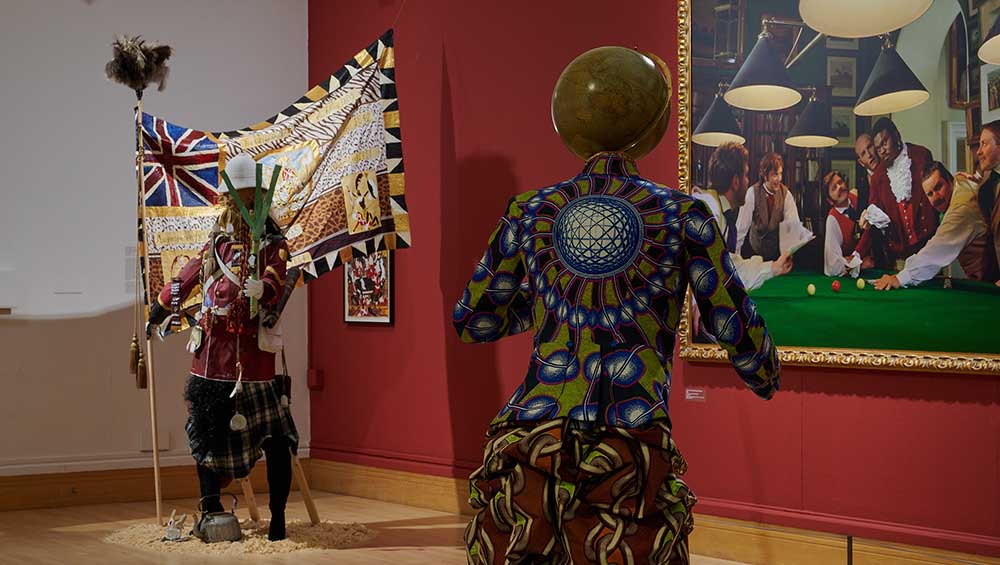
Reimag(in)ing the Victorians in Contemporary Art, installation view, Djanogly Gallery, Lakeside Arts, Nottingham, 23 September 2023 – 7 January 2024.
Djanogly Gallery, Lakeside Arts, Nottingham
23 September 2023 – 7 January 2024
by ANNA McNAY
What do you associate with the Victorian period? Pre-Raphaelite painting? Fairies? The development of photography? Charles Darwin’s theory of evolution? An increasing interest in the natural world? Colonialism? Well, all these fantastical – and sobering – ingredients come together in the cauldron of this slick exhibition, curated by Isobel Elstob, assistant professor in art history at the University of Nottingham, who has conjured it up as a visual expression of her forthcoming (and, sadly, prohibitively expensive) book of the same title (point being: see the show now free!). Spread through the four rooms of the Djanogly Gallery on the university campus, the exhibition marries magic and mystery, science and art, with a different flavour to each space, but a steady focus on the female and otherwise oppressed.

Andrew Gilbert. Major General Andrew Gilbert Calls a Drone Strike on his Leek Phone (tm), Magersfontein, 11th December 1899, Southern Africa, 2020. Installation view, Djanogly Gallery, Lakeside Arts, Nottingham. Courtesy Andrew Gilbert and Sperling
Munich.
Walking into the first room, one finds oneself immediately amid the action, with a mixed-media sculpture by the Scottish artist Andrew Gilbert – Major General Andrew Gilbert Calls a Drone Strike on his Leek Phone (tm), Magersfontein, 11th December 1899, Southern Africa (2020) – more than holding its own alongside three impressive Ankara-cloth-clad mannequins by Yinka Shonibare (I have never seen this many of his works in one exhibition, so this is quite a coup and a real treat). These headless figures, dressed in high-Victorian style (albeit cut from Shonibare’s trademark African wax-print material), and shown undertaking Enlightenment pursuits (such as astronomy and lepidoptery), highlight the links – and chasm – between this “Ur-British” intellectual society and slavery, a discordance that is furthered by the artist’s photographic series Diary of a Victorian Dandy: 11.00 hours; 17.00 hours; 03.00 hours (1998). Commissioned for display across the London Underground network, the works nod to William Hogarth’s A Rake’s Progress (1732-34), placing Shonibare at the centre of each scene – in bed with a proliferation of maids; half-cut on a chaise longue amid a scene of utter debauchery; and dressed in velvet and ruffles, taking charge at a billiard table – where, despite his sartorial and behavioural passing, his dark skin remains unsettlingly jarring. Standing alongside the mannequins, one feels uncomfortably complicit, and we are reminded, by the information panel, that the Victorians oversaw the largest empire the world has ever known: almost a quarter of the world’s land mass and more than a quarter of its population.
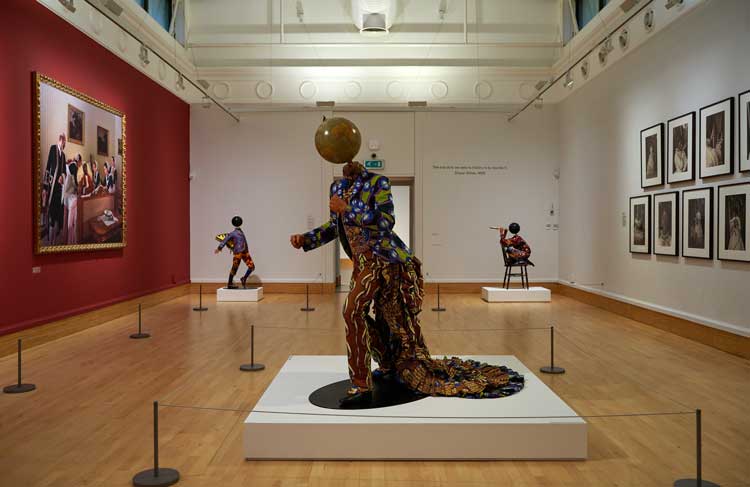
Yinka Shonibare RA. Earth, 2010. Fibreglass mannequin, Dutch wax-printed cotton textile, globe and metal, 180 x 190 x 190 cm. Wolverhampton Art Gallery.
Gilbert’s soldier similarly questions how colonial histories are memorialised in British popular culture. The parodic figure belongs to a fictional narrative of our past, constructed as much from ideological imagination as factual information. Appearing, at first, comical, the sculpture is a cutting critique of how British warfare continues to be packaged and presented to the public – 21st-century conflicts every bit as much as 19th-century battles. The quote from Oscar Wilde – “The one duty we owe to history is to rewrite it” – writ large on the facing wall, seems sadly bound for failure. In another corner, Sunil Gupta’s photographs, in the style of the pre-Raphaelites, further highlight this failure of an ideological imperialist project, speaking to the hypocrisy of British colonialism’s “civilising mission”, which led to the criminalisation of homosexuality in India.
Sculpture – of one kind or another: I include various forms of taxidermy under this umbrella – and photography comprise the mainstay of this exhibition, and, I have to say, some of the examples of the latter included are truly the most beautiful I have ever seen. One instance of this is The Valentine Days (2017), a luxuriant series of hand-tinted reworkings of a collection of colonial images by Ingrid Pollard. The original images were produced to promote the “rebellious” island of Jamaica to investors, but with Pollard’s tender care, the dignity of the Black subjects is restored. Her pastel tints bestow a dreamlike quality (to the “dream holiday”-style pictures) and serve to bring them to life in the present day.
,-2015,-Heather-Agyepong-(1).jpg)
Heather Agyepong. Too Many Blackamoors, 2015. C-Type colour print, 60.96 x 50.8 cm.
Nearby, Heather Agyepong’s Too Many Blackamoors (2015) – the title references Queen Elizabeth I’s complaint to the lord mayor of London that “several blackamoors have lately been brought into this realm, of which kind of people there are already too many here” – is a series of sumptuous photographs, inspired by a carte-de-visite of Queen Victoria’s adopted west-African goddaughter, Lady Sarah Forbes Bonetta, who came to live in England at a young age following the murder of her family. These self-portraits of the (actor and performance) artist in a richly elegant gown draw from Rosy Martin and Jo Spence’s re-enactment phototherapy concept, whereby the subject “restages” a significant life event, rewriting its ending or taking on a different role.
Agyepong says: “The images are based on my own personal experiences as a young Black woman, dealing with the macro and micro traumas of racism encountered while travelling around European countries. [It] aims to challenge the ‘strong, independent, Black female’ narrative that can burden and often entrap Black women.” Certainly, there is undeniable resilience in her facial expressions, but, as I know only too well myself, we (and here I speak as a woman who, although white and middle class, falls into numerous “minority” categories and lives with chronic health conditions) can be strong because we have to be, but sometimes simply wish we didn’t have to be.
The second room, Unnatural Histories, focuses on female scientists of the 19th century – or naturalists, as they would have been called. A film by Dorothy Cross, Come into the Garden Maude (2001), celebrates Maude Delap, the first person to successfully breed jellyfish in captivity (using bell jars in her kitchen, which she filled with seawater, collected by rowing boat, to recreate their natural environment). Her notes and drawings were published in The Irish Naturalist in 1901. Underwater imagery is combined with colour and musical interludes and a narration in the quintessentially upper-crust and dulcet tones of Fiona Shaw.
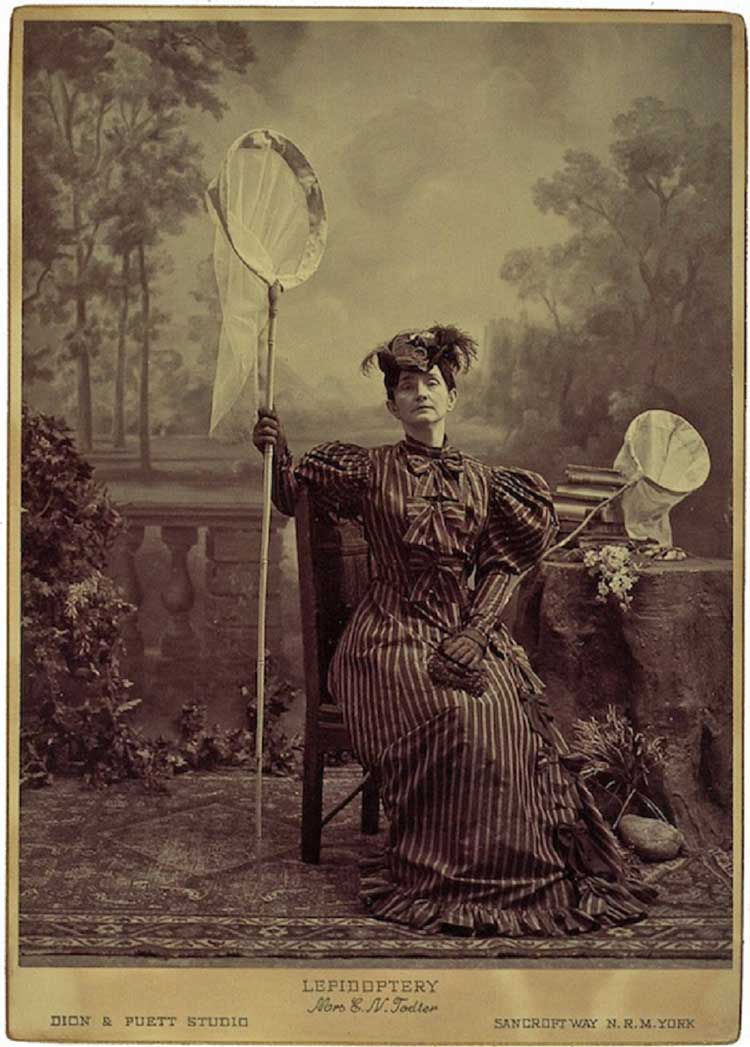
Mark Dion and J.Morgan Puett. Ladies' Field Club of York, Mrs. E.N. Todter, Lepidoptery, 1998. Photograph, gelatin
silver print on paper, 39 x 29.5 cm.
On the opposite wall, there are scientific studies and illustrations by women and a case containing some of Florence Nightingale’s childhood collection of shells, laid out in their original display drawers, with handwritten labels (from the university special collections). The Ladies’ Field Club of York (1998-99), a series of photographs by Mark Dion and J Morgan Puett, are staged as studio photographs depicting women with all the paraphernalia relating to their given “-ology” (labelled accordingly as anthropology, geology, palaeontology and so on). Field clubs in the Victorian period were filled with such amateur female naturalists, who gave huge amounts of data to their respective scientific pursuit, while remaining largely anonymous and uncredited. The cheeky twist here is that the models used for this series are leading female figures from the contemporary British art world. (I didn’t do very well with my identification, however.)
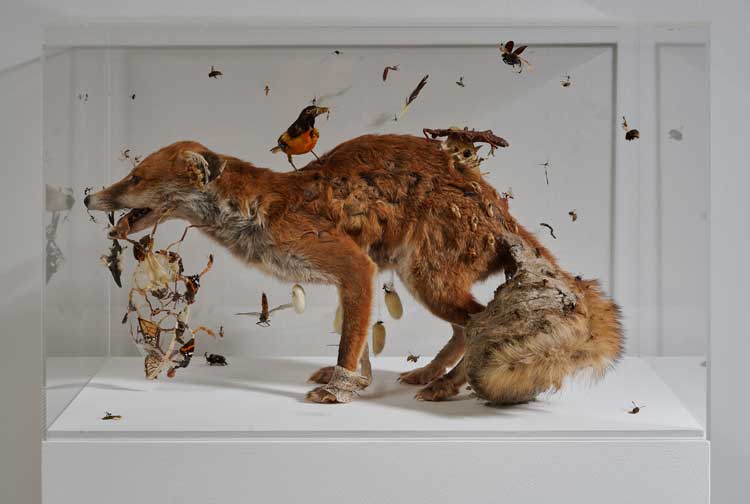
Reimag(in)ing the Victorians in Contemporary Art, installation view, Djanogly Gallery, Lakeside Arts, Nottingham, 23 September 2023 – 7 January 2024.
The third room is titled The Animal Body Remade and is a veritable menagerie. The Victorians were passionate about the natural world but, due to their belief in nature’s infinity, many creatures ended their lives as specimens in collectors’ drawers, hunting trophies or accessorising fashion wear. (In the context of this exhibition, one might argue that the 19th-century Brits equally “colonised” and mistreated the animal kingdom.) Taxidermy emerged as a popular art, and the works on display here combine the Victorian with the contemporary (the latter are all ethically approved, using animals and insects that have died of natural causes), interweaving and juxtaposing the two so deftly that one cannot help but question: What here is art and what is science? There are further “standalone” loans from the university collections, including a cabinet with lepidoptera specimens (butterflies and moths), but those from Nottingham City Museum’s collection, placed in conversation with the contemporary art works, are more show-stealing.
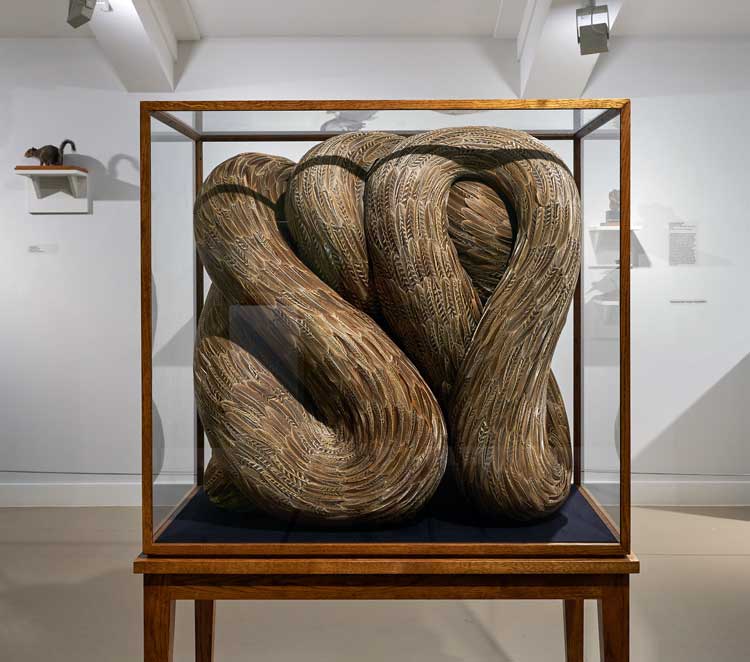
Kate MccGwire. Gyrus, 2019. Mixed media with pheasant feathers in bespoke cabinet, 160 x 100 x 60 cm. © Kate MccGwire.
While Kate MccGwire works wonders with feathers, making reference especially to the 19th-century German zoologist Ernst Haeckel, it is Polly Morgan, and most especially Tessa Farmer, whose works really stand out. Morgan, who turned to working with freeze-dried snakeskins during the pandemic (and there is one such recent work included here), is better-known for her delightfully surreal earlier pieces, such as Someone on the Phone #2 (2007) – a taxidermy magpie perched on a black Bakelite phone, which conjures up imagery by Salvador Dalí and René Magritte and yet doesn’t seem out of place alongside a humble taxidermy pigeon. Untitled (2007) – a taxidermy squirrel nestled in a champagne coupe – is similarly paired with a lowly grey squirrel from the museum collection.
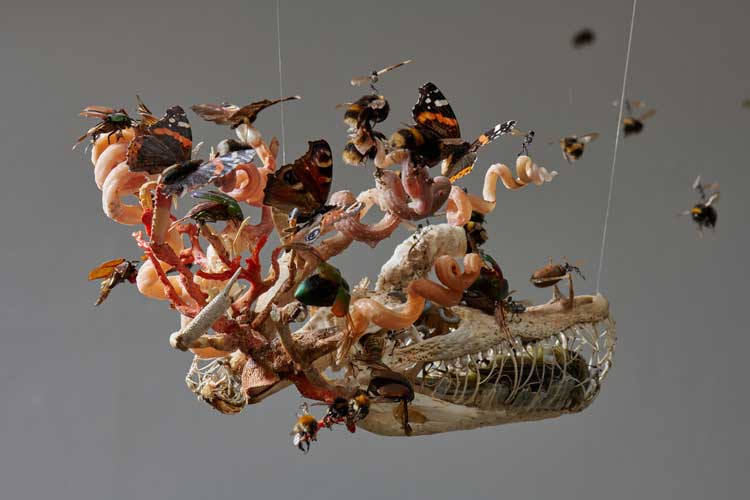
Tessa Farmer. Swarming Fever, 2021. Bones, insects, plant roots, Portuguese Man O'War, polyps, taxidermy birds, worm shells, snakeskin, sea spiders, hedgehog spines, approx. 150 x 300 cm.
Farmer’s works take the exhibition to another level – and the visitor to another world. Her insanely intricate and beautiful “aerial tableaux” transport us to a land in which minute skeleton fairies seek dominion over the natural world and to annihilate all creatures larger than themselves. In Swarming Fever (2021), she uses bones, insects, plant roots, Portuguese man o’ war, polyps, taxidermy birds, worm shells, snakeskin, sea spiders and hedgehog spines to painstakingly craft sadistic fairies, who are chasing a fleeing bird, and have enslaved a swarm of bumble bees, reappropriating their bodies as fighter planes. There is also a skeletal ship – modified for battle with crab claws, snake ribs, mouse ribs, worm shells and coral – kept airborne by enslaved butterflies. The play of shadows on the gallery walls is magical, drawing visitors in like curious children, but they are met with scenes of sheer and utter cruelty and vicious warfare (sound familiar?). While today we might think of fairies as good and kindly spirits, this twisted Victorian kind was commonplace, doubtlessly influenced by Darwin’s theory of evolution by natural selection, which emphasised the absolute brutality of nature.
More immediately disturbing examples of Farmer’s work, given their scale and harsh “reality” by comparison to the more narrative, otherworldly fairy tale of the insect work, are Little Savages (2007), comprising a taxidermy fox being eaten alive (again by fairies), and A Wounded Herring Gull (2013), which incorporates an original Victorian specimen produced by the taxidermist George Bazeley. As with Morgan’s works, this is set alongside an original taxidermy artefact (from the museum collection) of a carrion crow with its prey. Nearby, a confusion of colourful birds in a glass bell jar seems every bit as creative and improbable as many a contemporary work of art, but it is, in fact, another original specimen.
The exhibition concludes with a small room of photography on the theme of Females Through the Lens. My all-time favourite contemporary photographer, the actively feminist Nicolas Laborie, is represented by his utterly beguiling series Lilith’s Spells (2016), made using the traditional wet-plate-collodion technique, and, to my mind, he outshines even the great Lady Clementina Hawarden and Julia Margaret Cameron. The “maternal narcissism” of these Victorian women is, however, effectively set against the contemporary work of Sally Mann, who uses a large-format bellows camera to create ambiguous portraits of young girls, including her own daughters, in the series Immediate Family (1980s).
In summary, this is a wonderful exhibition, the result of rigorous academic research and reasoning, but absolutely led, nevertheless, by aesthetics. The diachronic dissonances and surprising syntheses truly lead one to “reimag(in)e” the Victorians, their legacy and our contemporary selves.